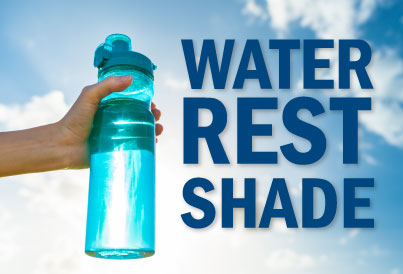
Most heat-related health problems can be prevented, or the risk of developing them can be reduced.
Engineering Controls
The best way to prevent heat-related illness is to make the work environment cooler. A variety of engineering controls can reduce indoor workers' exposure to heat:
- Air conditioning (such as air-conditioned crane or construction equipment cabs, air conditioning in break rooms).
- Increased general ventilation.
- Cooling fans.
- Local exhaust ventilation at points of high heat production or moisture (such as exhaust hoods in laundry rooms).
- Reflective shields to redirect radiant heat.
- Insulation of hot surfaces (such as furnace walls).
- Elimination of steam leaks.
Work Practices
- Employers should have an emergency plan in place that specifies what to do if a worker has signs of heat-related illness, and ensures that medical services are available if needed.
- Employers should take steps that help workers become acclimatized (gradually build up exposure to heat), especially workers who are new to working in the heat or have been away from work for a week or more. Gradually increase workloads and allow more frequent breaks during the first week of work.
- Workers must have adequate safe drinking water close to the work area, and should drink small amounts frequently.
- Rather than being exposed to heat for extended periods of time, workers should, wherever possible, be permitted to distribute the workload evenly over the day and incorporate work/rest cycles.
- If possible, physical demands should be reduced during hot weather, or heavier work scheduled for cooler times of the day.
- Rotating job functions among workers can help minimize overexertion and heat exposure.
- Workers should watch each other for symptoms of heat-related illness and administer appropriate first aid to anyone who is developing a heat-related illness.
- In some situations, employers may need to conduct physiological monitoring of workers.
Personal Protective Equipment
Workers should be aware that use of certain personal protective equipment (e.g., certain types of respirators and impermeable clothing) can increase the risk of heat-related illness.
In some situations, special cooling devices can protect workers in hot environments:
- In some workplaces, insulated gloves, insulated suits, reflective clothing, or infrared reflecting face shields may be needed.
- Thermally conditioned clothing might be used for extremely hot conditions; for example:
- A garment with a self-contained air conditioner in a backpack.
- A garment with a compressed air source that feeds cool air through a vortex tube.
- A plastic jacket whose pockets can be filled with dry ice or containers of ice.
Training
Workers and supervisors should be trained about the hazards of heat exposure and their prevention. Topics should include:
- Risk factors for heat-related illness.
- Different types of heat-related illness, including how to recognize common signs and symptoms.
- Heat-related illness prevention procedures.
- Importance of drinking small quantities of water often.
- Importance of acclimatization, how it is developed, and how your worksite procedures address it.
- Importance of immediately reporting signs or symptoms of heat-related illness to the supervisor.
- Procedures for responding to possible heat-related illness.
- Procedures to follow when contacting emergency medical services.
- Procedures to ensure that clear and precise directions to the work site will be provided to emergency medical services.
Source: OSHA.gov
Categorized in:
-
Driving Techniques
-
Health & Wellness
-
Injury Prevention
ClickToAddCategories
No categories have been created yet.
Community
Company Updates
Driver Recruitment
Investor News
Transportation Safety
Claims
Driver Management
Driving Techniques
Distracted Driving
Seasonal Driving Tips
Sharing the Road
Health & Wellness
Injury Prevention
Regulations
Security & Cargo Theft
Vehicle Inspections
Weather Conditions
Workplace Safety
Workers Compensation
Done